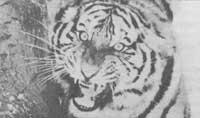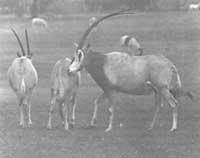Text written in Basque and translated automatically by
Elia without any subsequent editing.
SEE ORIGINAL
Zoos: Animal warehouse?
1990/10/01
Barandiaran, Mariaje | Irazabalbeitia, Inaki - kimikaria eta zientzia-dibulgatzaileaElhuyar Fundazioa
Iturria:
Elhuyar aldizkaria
In most of the big cities in the world, and in many small towns, there are zoological parks. Those of some cities are, in addition, very famous for their structure or for the abundance of exotic animals that group them.
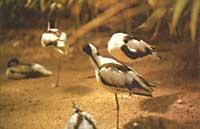 Abozeta (Recuvirostra avosseta) is a visitor of our humid zones in their annual autumn and spring migrations. The brood is spent in the central Asian and European and winter in the African rift valley. They feed on small animals that live in the mud and their long peaks, 9 cm., help them a lot. Zoo of Stutgart. (Photo: I.X.I. ). In most of the big cities in the world, and in many small towns, there are zoological parks. Those of some cities are, in addition, very famous for their structure or for the abundance of exotic animals that group them. Large flocks of tourists accumulate on the doors of these zoos, with the aim of seeing the lion goat or the disparate acrobatics of the monkeys. The children have a good time. We are no longer children, but when we go to a new city we do not miss the opportunity to visit the zoo. We have seen a machine and although everyone has something special, it is two that have impressed us especially: Chicago and Stutgard. The first is huge in size, with the same flavor of many American things, and the animals are at home. Stutgard's is smaller but fascinating, at the same time, due to the high degree of landscape integration that have reached the different buildings and structures of the zoo: it seems you are in a normal park. 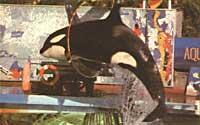 The orca (Orcinus orca) is a whale, known in many languages as a killer. However, this bad reputation marine mammal is a bright star of many dolphins. Dolphinate, the largest species in the dolphin family, can reach 9.5 m in length. All the seas of the world run on the hunt for fish and cephalopods you need to eat. A quarantine lives in groups of units and is a very social animal. Like all dolphins, it is a fast animal that learns with ease the tricks and works taught. (Photo: X. Goñi). The zoos, however, have generated many debates. For some, they are just animal crests. Animals enter cages, in a small space and under conditions outside the original conditions, many say. The animals get mad and die in a strange and stressful environment. The example of the monkey playing the bell constantly or the bear spinning without resting in a few square meters has been mentioned several times. There was no lack of reasons to those who said it in their day, since the zoos were often storage of animals. However, at present there is another philosophy among those responsible for the zoo: bringing the environment of the shelter to the maximum of the original conditions of the animals. From this road great efforts are being made and when visiting the zoos are remarkable the works of innovation made in recent years. 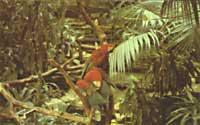 Parrots or parrots, spectacular birds of the Psittacidae family. They live mostly in forests of Africa, Asia, Oceania and America, and some have a great capacity to imitate human language. For this same reason and for its precious pen, hunters capture them and their market is very productive. Consequently, some species of papagayo are in serious danger. Chicago Zoo. I.X.I. In addition, zoos have another important function: to be shelter and place of reproduction of endangered species in nature. There are several species of South American monkey that are dispersed by zoos around the world more than in the original tropical forests. Thanks to the collaboration between the different zoos, these species reproduce in the zoos and are returned to the original regions. This has been done with Orixa for example. Another highlight is the problem of zoos. Usually, zoos are considered as exhibitors of exotic animals from remote places. We believe that this vision is broken and that those responsible for zoos should pay more attention to the fauna of the place where the zoos are located. Zoos can do incredible educational work in favor of the tendencies of protection of nature, teaching citizens how nature is. 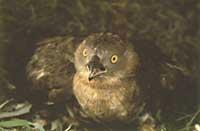 The listorero falcon (Pernis apivorus) is a prey bird that grows in our forests. Species dispersed throughout Eurasia, it grows between the Mediterranean and Scandinavia, but inverts in tropical Africa. Among us it is not very abundant and the largest number of specimens is observed in September when they are directed to the south. Breeding in the open forest of our village, although it is not very abundant among us. The most remarkable feature of this falcon is the diet, which is mainly fed by wasps and bees. However, it does not deny other insects and small mammals. It usually does not feed flying, but if it does on surface. Look for wasp nests made on the ground and when you find them eat the larvae that have deteriorated with the claws and have been exposed. To combat the sting of wasps and bees, the area of the peaks and eyes is protected by compact feathers formed by small feathers. On the other hand, it seems very similar to the common falcon and sometimes it is not surprising that they are mixed. However, the wasp has a more stylized look. House of the Eagle of Igeldo. (Photo: I.X.I). That is, demonstrating that the fight for nature is not only a fight for the whales or tropical forests, but also for the frog that lives in the pond adjacent to the house. Unfortunately, people often know better the details of the African lion than those of the catajistas of our mountains. Therefore, how they are, how they seem, how they live, etc. Zoos can do an important job showing. To finish, we want to ask a question: When is a zoo in Euskal Herria? 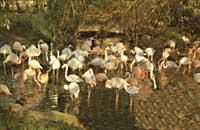 Under the name of flamenco are grouped four species of birds of the family Phoenicopteridae. They are between 90 and 150 cm tall and their color varies between white and pink. Flamingos are gregarious birds that are grouped in groups of hundreds of individuals. They cover shallow waters and feed on a special peak of organic and small animals present in the water. Paris Zoo. I.X.I. 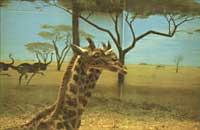 Giraffe ( Giraffa camelopardalis ) is the highest mammal and can reach 5.5 m of height. Its appearance is quite comic due to its long neck. Although the neck is long, as in the case of other mammals, it has only seven vertebrae, of large size. Giraffe lives in groups in the African savannah. It is mainly fed by acacia leaves. His only enemy, besides the human being, is the lion and flees as a defense, because it is quite fast. It can run at 48 km/h. After about 15 months of breeding she gives birth with a single child. In this photo, made in the zoo of Paris, it is observed that in the background wall the African savannah has been painted. (Photo: I.X.I. ). 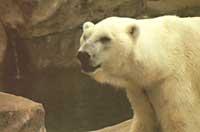 The polar bear ( Ursus maritimus ) is an excellent example of stress produced by zoos in some animals. The truth is that the narrow limits of a cage for this animal that runs relentlessly through the immense ice plains of the Arctic must be suffocating. Therefore, in the zoos it is not strange to see them in a tour without end. The polar bear is a huge mammal: It can weigh 720 kg and measure 2,5 m. It feeds mainly on the seals it captures in the archaic banquisa. Being protected by a thick layer of fat, he is not afraid of cold waters and is a good swimmer. On the other hand, the polar bear must withstand human pressure, especially from hunters who seek trophies. The Eskimo also hunt for the raw materials needed to survive (sow, leather, meat and fat). Zoo of Madrid. (Photo: I.X.I. ). 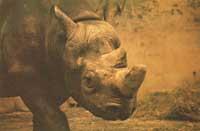 The fate of the rhinoceros is as black as night. According to Eastern popular medicine, the powder of the rhino branch has admirable properties and serves to cure many diseases. Therefore, the poaching of this huge animal can send to the limbo of the missing species before the end of the century. The protective measures, even the strictest ones, are failing and in recent years the number of rhinos is decreasing. Zoos can be their last refuge. Zoo of Madrid. I.X.I. 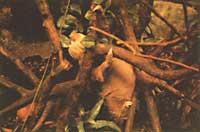 Sloths are the most useless animals in the world. They spend hours hanging from the branches without barely moving and when they begin to move it seems that the camera is at rest. These animals, together with the armadillos and the anteaters, form the order Edenata. The sloths measure between 60 and 70 cm and the front legs are longer than the rear. Most mammals have seven vertebrae in the neck, while the sloths have nine. In addition, they can turn the head 270°. Its activity is mainly nocturnal. They do not usually come down from the trees, due to their clumsiness in the soil and to the ease of dams like jaguar. They feed on leaves. Chicago Zoo. I.X.I. 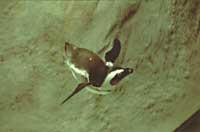 The penguins, the elegant clowns of antarctica, can be found in all zoos and it is spectacular to follow their travels. It seems that around a pond the sardines are enough and live happy. Madison Zoo. I.X.I. 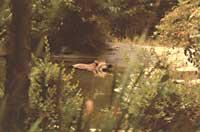 Tapirra is a mammal that lives in the forests of Malaysia and South America. Robust body and short legs. They can have a length of 2,5 m. The tapiros inhabit closed forests and marshes, never far from water. In America the jaguar and the tiger Malaysia are his only enemies aside from man. The photo is made in the Chicago Zoo, although it seems to be made in the dense Amazon forests. I.X.I. 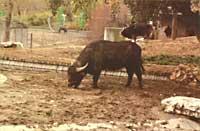 Zoos are not only exotic and rare animals, but also animals like the Indian Buffalo (Bubalus bubalis). This robust animal is used as a working animal in many territories of the world for thousands of years, when it was raised in India. Its branches are impressive and can measure 1.8 m from end to end. (Photo: I.X.I. ). 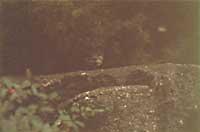 The otter ( Lutra lutra ) is an elegant animal, only visible to swim. This mistletoe was once the king of our waters, but today unfortunately it is increasingly scarce. The degradation of water quality and human pressure (their skin is highly appreciated) are causing the disappearance of the otter among us. The locations are scarce and unknown. It is said to exist, but not: it seems a state secret. Proof of this is the treatment of the government of Navarre with the British: The grilled vultures of Navarre by the Welsh otters. The males of the otter can weigh 11 kg. Brown skin and very fine coat. The otter is a nocturnal and solitary animal. It lives in the water and although the fish are their main foods, they also eat amphibians, aquatic birds and invertebrates. London Zoo. Animals like the otter would deserve a special place in the pending zoo of Euskal Herria. (Photo: I.X.I. ). 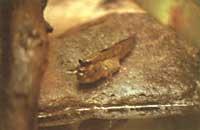 Lung fish live in lakes and ponds of water from Africa. Its main characteristic is to be able to breathe both on land and in water. They are evolutionary witnesses of an important level of chains in the conquest of the land. Zoo of Stutgart. I.X.I. 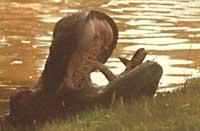 The hippopotamus amphibius goat ( Hippopotamus amphibius ) seems to be able to swallow anything. However, it only eats aquatic plants. Hippopotamus lives in large groups in rivers and swamps of Africa. He is a good swimmer, but on land he is a quick runner at a short distance. It can reach to weigh up to 5 tons of the largest specimens. Africans have the hippo meat very to taste and this animal must withstand the pressure of hunting. However, it is not a threatened species. (Photo: X. Goñi). 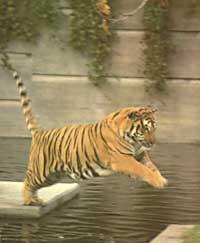 Tiger! Tiger! We cannot finish this mention without mentioning one of the most beautiful animals and at the same time one of the most threatened: the tiger (Leo tigris). In this photograph taken by Xanti Goñi is skipping elegantly away from its Bengali origin. This large cat can reach a length of 2.2 m and a weight of 390 kg. It lives in dense forests and marshes. It feeds mainly on mammals and sometimes the old or mutilated tigers are dedicated to the hunting of man, since we are prey easier than wild animals. (Photo: X. Goñi). 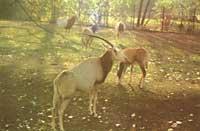 The genus Orix is composed of three species: the Arabic orix ( Oryx leucoryx ), the cymbine orix with horn ( Oryx dam{ ) and the gemsbok orixa ( Oryx gazella ). Orixa lives in semi-amortized regions in Africa and the Middle East. They have suffered enormous human pressure and the white orix of North Africa and the orix of Arabia has been in danger of extinction. Thanks to the orixes raised in the zoos, it has been possible that these two species return to their original areas. In the image the white orix of the zoo of Paris. (Photo: I.X.I. ). |





















